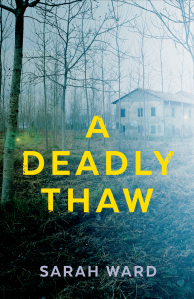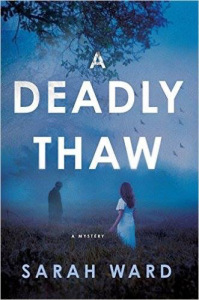Sarah Ward's Blog, page 18
May 9, 2016
Barbara Nadel – Enough Rope
Post by 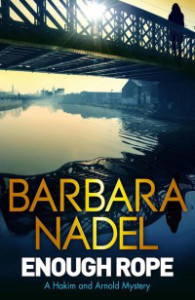 Crimepieces guest reviewer, Rachel Hall.
Crimepieces guest reviewer, Rachel Hall.
Barbara Nadel is familiar to many readers as the author of the well-regarded Inspector Ikmen series set in Istanbul, however my first encounter with her work comes with the fourth outing of the London based Hakim and Arnold series. Set in the East End, the series revolves around a small private detective agency run by white ex-policeman Lee Arnold and his assistant, young Muslim widow Mumtaz Hakim. Barbara Nadel has pulled off something quite special in Mrs Mumtaz Hakim. Mumtaz adds a layer of realism which offers a fresh perspective on an area which has seen vast changes over recent years and is largely unrecognisable to half a century ago.
With a significant Bangladeshi community making up a large part of the population around Brick Lane and the East End, Mumtaz has a solid support network established in the area. Well educated with a degree in psychology she is a strong independent woman working in an occupation still predominantly seen as the preserve of white males. As a step-mother to sixteen year old Shazia she has plenty of her own problems, burdened by the debts left by husband Ahmet to Naz Sheikh and his family and with their threats increasing being levelled at Shazia, not to mention brother Asif.
Whilst Lee hails from the Forest Gate area and as a divorced, ex-cop, ex-army private investigator could be seen as largely ‘old school’, he is clearly no dinosaur and is insightful enough to know that to make inroads in a community where the demographic is rapidly changing he needs support. The established crime families of the East End no longer reign and with a growing community of Muslims and a shift towards the upwardly mobile university elite, a more diverse community are bringing a wider range of crimes and corruption to his attention.
When Superintendent Paul Venus’ son, Harry, is kidnapped and a ransom demanded from an address in Brick Lane it is not just his boy he wants back; he also wants to know who is behind the sting and employs Arnold in an attempt to achieve a discreet resolution. Although by no means friends the pair and well aware of each other and with ex-colleagues still working under the authority of Venus, Lee has heard all the rumours of corruption and backhanders coming from on-off hook-up DS Violet Collins. Yet the ransom demand address of Brick Lane cannot be dismissed outright and when Mumtaz uncovers a connection which points to a powerful Bangladeshi family things no longer seem so straightforward. With Lee being sworn to secrecy about the case he has to tread very carefully and rely on the mutual trust which the pair have fostered. Arnold has no contacts in the Muslim community, whereas Mumtaz has a family home and not only relatives but friends and connections to the community.
What Enough Rope lacked in frenetic action it more than made up for with its striking portrayal of life for the residents of a diverse East End and still delivered plenty of twists to keep me focused. Admittedly one outcome did strike me as rather contrived and a little left of centre but on the upside there was much to applaud. The supporting characters all have real depth, most noticeably Shazia, Vi Collins and father Baharat and I would be interested in seeing more of them. Well paced and a lively sense of humour in evidence throughout from both the old and new residents which I particularly liked. With Lee showing an increasing attraction to Mumtaz there may be a relationship on the cards but the bond between the pair seems genuine and adds a real plausibility which ensures that the series never feels like tokenism.
Originally hailing from the East End there is no doubt that Nadel is familiar with the cultures and communities who occupy the area. Gentrification and growing inequality fosters ill feeling, not just between the ‘haves and have nots’ but also between minority groups. The achievement which sets Enough Rope apart is in presenting individuals and a cross section of each ethnic group, not just depicting stereotypes. Most notably within Mumtaz’s family as brother Asif is increasing drawn to radicalisation it is her elderly father, Baharat, whose tolerance creates the lasting memory.
There was a sense of vibrancy throughout the novel and in the same way that Anya Lipska has brought the Polish community around Stratford alive, Barbara Nadel is doing a brilliant job for the Bangladeshi community of Brick Lane. I make no apologies for my new found enthusiasm for this series and if you enjoy a solid crime read with a little more of social context then this series is a very decent bet!


May 3, 2016
Review: Fiona Barton – The Widow
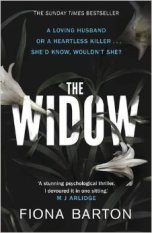 The Widow is a book everyone’s been talking about this year. It seems to have divided some readers but I found it to be an engrossing read with a slightly old-fashioned feel which I liked. I met its author, Fiona Barton, at a recent event and she spoke eloquently about how she came to publish this, her debut novel. The plot has a deceptively simple premise: a woman whose dead husband is believed to be a child murderer is now able to speak out to the press about the accusations levelled against him. How much does she know and does she believe in his guilt?
The Widow is a book everyone’s been talking about this year. It seems to have divided some readers but I found it to be an engrossing read with a slightly old-fashioned feel which I liked. I met its author, Fiona Barton, at a recent event and she spoke eloquently about how she came to publish this, her debut novel. The plot has a deceptively simple premise: a woman whose dead husband is believed to be a child murderer is now able to speak out to the press about the accusations levelled against him. How much does she know and does she believe in his guilt?
The book has a split narrative. Jean is the wife of Glen a delivery driver who police believe is responsible for the kidnapping of two year-old Bella. Now that he is dead, she is persuaded to tell her side of the story to a newspaper. Reporter Kate Waters is adept at getting her interviewees to reveal more than they expected but Jean is a complex character who has buried the truth deep down within her. The reader is also introduced to detective Bob Sparkes who has led the investigation into Bella’s disappearance. His inability to find her, dead or alive, has meant him being sidelined in his job and pilloried by the press.
The Widow is one of those rare books where I enjoyed each narrative voice equally. I think this was largely because of the strength of characterisation of Kate, the intrepid reporter. Fiona Barton has worked as a journalist on national newspapers and clearly has a in-depth knowledge of the industry. Kate is portrayed as both determined and compassionate with a sceptical view of Jean’s story. Jean is a woman from a different generation. She has come depend on Glenn completely and believes his excuses. Or so it seems. For Jean also has hidden depths to her.
It was a certainly a page-turning read. There’s something compulsive about Jean’s blindness to Glenn’s activities and we, as readers, are desperate to know what happened to Bella. It’s a horrible subject matter but Barton doesn’t go into unnecessary detail. A book that, for me, lived up to the hype.


April 25, 2016
Review: Renee Knight – Disclaimer
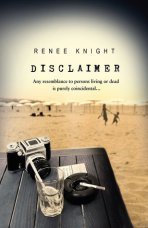 I met Renee Knight at a recent event at Reading Matters Bookshop in Chapel-en-le-Frith. We had an interesting discussion about the genesis of Disclaimer which Knight wrote after attending a Faber Academy course. Disclaimer has been published to great acclaim and it certainly was a page-turning read. It’s a take on using an unreliable narrator to leave the reader exposed but I was also interested in the extent to which the book gives a realistic and often damning portrait of family life.
I met Renee Knight at a recent event at Reading Matters Bookshop in Chapel-en-le-Frith. We had an interesting discussion about the genesis of Disclaimer which Knight wrote after attending a Faber Academy course. Disclaimer has been published to great acclaim and it certainly was a page-turning read. It’s a take on using an unreliable narrator to leave the reader exposed but I was also interested in the extent to which the book gives a realistic and often damning portrait of family life.
Catherine has recently moved into a new house with her husband, Robert. She finds a book she can’t remember purchasing which details an event that occurred twenty years earlier. So shocking was the tragedy that it nearly claimed the life of her son and she has never spoken of it to anyone. Someone, however, clearly knows the details and is taunting her with expose and retribution.
This is an interesting book with quite a slow pace to begin with that picks up speed in the last third. The two narrators are Catherine, desperate to discover who knows her secret, and a retired male school teacher who is taunting Catherine with what he knows. Knight does a good job in getting readers to try to discover what Catherine is hiding without feeling manipulated. Catherine isn’t particularly an easy character to like as she makes odd decisions and puts up with poor behaviour from both her husband and son. This didn’t bother me as I don’t particularly need to like a character to identify with them.
Ultimately, I found Disclaimer to be a damning portrayal of a marriage and the secrets that are contained within it. There’s a slight redemptive feel towards the end and I’m not surprised by the book’s success.


April 19, 2016
The Petrona Award 2016 Shortlist
 We’re announcing today the shortlist for the 2016 Petrona Award.
We’re announcing today the shortlist for the 2016 Petrona Award.
Six top quality books from Finland, Sweden and Norway have made the shortlist. They are:
THE DROWNED BOY by Karin Fossum tr. Kari Dickson (Harvill Secker; Norway)
THE DEFENCELESS by Kati Hiekkapelto tr. David Hackston (Orenda Books; Finland)
THE CAVEMAN by Jorn Lier Horst tr. Anne Bruce (Sandstone Press; Norway)
THE GIRL IN THE SPIDER’S WEB by David Lagercrantz tr. George Goulding (MacLehose Press; Sweden)
SATELLITE PEOPLE by Hans Olav Lahlum tr. Kari Dickson (Mantle/Pan Macmillan; Norway)
DARK AS MY HEART by Antti Tuomainen tr. Lola Rogers (Harvill Secker; Finland)
The winning title will be announced at the Gala Dinner on 21 May during the annual international crime fiction event CrimeFest, held in Bristol 19-22 May 2016.
The award is open to crime fiction in translation, either written by a Scandinavian author or set in Scandinavia and published in the UK in the previous calendar year.
The judges’ comments on the shortlist:
THE DROWNED BOY by Karin Fossum tr. Kari Dickson (Harvill Secker; Norway)
Fossum’s spare prose and straightforward narrative belie the complexity at the heart of this novel. After the drowning of a young child with Down’s Syndrome, Chief Inspector Sejer must ask himself if one of the parents could have been involved. The nature of grief is explored, along with the experience of parenting children with learning difficulties. There’s a timeless feel to the writing and a sense of justice slowly coming to pass.
THE DEFENCELESS by Kati Hiekkapelto tr. David Hackston (Orenda Books; Finland)
The second in Hiekkapelto’s ‘Anna Fekete’ series is an assured police procedural rooted in the tradition of the Nordic social crime novel. Its exploration of immigrant experiences is nuanced and timely, and is woven into an absorbing mystery involving an elderly man’s death and the escalating activities of an international gang. A mature work by a writer who is unafraid to take on challenging topics.
THE CAVEMAN by Jorn Lier Horst tr. Anne Bruce (Sandstone Press; Norway)
Horst’s The Caveman begins with the discovery of a four-month-old corpse just down the road from William Wisting’s home. Troubled by his neighbour’s lonely death in an apparently uncaring society, the Chief Inspector embarks on one of the most disturbing cases of his career. Beautifully written, this crime novel is a gripping read that draws on the author’s own experiences to provide genuine insights into police procedure and investigation.
THE GIRL IN THE SPIDER’S WEB by David Lagercrantz tr. George Goulding (MacLehose Press; Sweden)
The late Stieg Larsson created the groundbreaking, two-fingers-to-society, bisexual anti-heroine Lisbeth Salander. When Larsson’s publishers commissioned a fourth book, they turned to David Lagercrantz, whose The Girl in the Spider’s Web often reads uncannily like Larsson’s own text. His real achievement is the subtle development of Salander’s character; she remains (in Lagercrantz’s hands) the most enigmatic and fascinating anti-heroine in fiction.
SATELLITE PEOPLE by Hans Olav Lahlum tr. Kari Dickson (Mantle/Pan Macmillan; Norway)
An accomplished homage to Agatha Christie, Satellite People adds a Nordic twist to classic crime fiction tropes. References to Christie novels abound, but Lahlum uses a Golden Age narrative structure to explore Norway’s wartime past, as Inspector Kristiansen and Patricia investigate a former Resistance fighter’s death. Excellent characterisation, a tight plot and a growing sense of menace keep the reader guessing until the denouement.
DARK AS MY HEART by Antti Tuomainen tr. Lola Rogers (Harvill Secker; Finland)
Tuomainen’s powerful and involving literary crime novel has a mesmerising central concept: thirty-year-old Aleksi is sure he knows who was behind his mother’s disappearance two decades ago, but can he prove it? And to what extent does his quest for justice mask an increasingly unhealthy obsession with the past? Rarely has atmosphere in a Nordic Noir novel been conjured so evocatively.
With grateful thanks to each of the translators for their skill and expertise in bringing us these outstanding examples of Scandinavian crime fiction.
The judges are:
Barry Forshaw – Writer and journalist specialising in crime fiction and film; author of four books covering Scandinavian crime fiction: NORDIC NOIR, DEATH IN A COLD CLIMATE, EURO NOIR and the first biography of Stieg Larsson.
Dr. Katharina Hall – Associate Professor of German at Swansea University; editor of CRIME FICTION IN GERMAN: DER KRIMI for University of Wales Press; international crime fiction reviewer/blogger at MRS. PEABODY INVESTIGATES.
Sarah Ward – Crime novelist, author of IN BITTER CHILL (Faber and Faber), and crime fiction blogger at CRIMEPIECES.
More information can be found on the Petrona Award website


April 18, 2016
Review and Q & A: Lauren A Forry – Abigale Hall
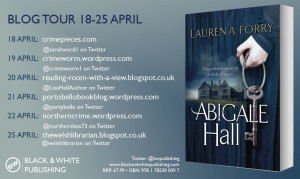 Abigale Hall, by debut author Lauren A Forry is published this week. I love a good creepy tale especially one set in the Welsh countryside and this one is a great read. Abigale Hall is the tale of two sisters who are sent away from post-war London by their aunt to work in an isolated Welsh mansion. Seventeen-year-old Eliza finds evidence of past servants who appear to have come to a sticky end while her sister, Rebecca, comes under the spell of housekeeper Mrs Pollard. It’s deliciously creepy read with a strong sense of menace.
Abigale Hall, by debut author Lauren A Forry is published this week. I love a good creepy tale especially one set in the Welsh countryside and this one is a great read. Abigale Hall is the tale of two sisters who are sent away from post-war London by their aunt to work in an isolated Welsh mansion. Seventeen-year-old Eliza finds evidence of past servants who appear to have come to a sticky end while her sister, Rebecca, comes under the spell of housekeeper Mrs Pollard. It’s deliciously creepy read with a strong sense of menace.
The author, Lauren, has answered some questions about the book as I’m always fascinated how a debut author’s book came into being. Thanks to Lauren for her fascinating and detailed answers.
You’re a debut author. Can you tell me why you decided to write a crime novel?
My dad was a Special Agent for the FBI, so I’ve always been interested in crime. He and I watched all sorts of TV crime and murder mysteries, our two favourites being The X-Files and PBS Masterpiece Mystery!, which had an intro set to animated Edward Gorey drawings and aired British mystery shows like Poirot and Miss Marple, and darker mini-series as well. (PBS is the USA’s main public broadcasting channel.) Both my parents also loved reading mysteries, too. My mom has an autographed copy of an Agatha Christie book that she won for solving the “crime” at a murder-mystery dinner theatre show.
The FBI was definitely my biggest influence growing up, though. I had a toy FBI kit and used to go around fingerprinting my family then dusting for prints in various rooms, trying to see if I could make a match. I also used to walk through the woods around my house, looking for evidence (which usually related to whatever episode of The X-Files aired that week). I probably would have become an FBI agent myself, except I have a compressed disc in my spine that would have prevented me from passing the physical fitness requirements for special agents. But if I couldn’t solve real mysteries, I could at least write my own.
You’ve set most of your book in an isolated Welsh house. What made you choose this location?
I first visited Wales in 2008. I was living in London and working in a pub after graduating university, and I mainly wanted to go to Cardiff to see where they filmed Doctor Who and Torchwood. My mom had never been to Wales, either, so she flew over and came along with me. While I enjoyed seeing Doctor Who filming locations, what really struck me was the beauty of Wales along with its isolation. There was a certain atmosphere there, a different energy, than what I had experienced on previous trips to Ireland and Scotland that really stuck with me.
I never minded isolation because I grew up in a house in a secluded area (though not as secluded as the house in Abigale Hall). I was always amused when my friends from New York and other cities would visit because they would get so scared, just by the silence, as if something was going to jump out of the quiet at any moment. The very first time a close college friend of mine (who lives in the Bronx) visited my house, we were driving back from the bus station, and it was dark and very foggy. When we reached a stop sign, she asked which way we were turning, and I told her we weren’t. My house was straight ahead. She saw the dirt road ahead of us through the fog and shouted, “But we can’t go straight!” To this day, she needs to use a white noise machine when she visits or else she can’t sleep at night.
When I started to brainstorm the idea for Abigale Hall, these two ideas kind of coalesced, and I thought about how difficult it would be for a girl born and bred in London to be suddenly transplanted to such a secluded area, especially in an era without the internet or smart phones that could help her maintain contacts with the familiar. Eliza’s first approach to Abigale Hall definitely has similarities to my friend’s first visit to my house.
The relationship between two sisters is explored in Abigale Hall. Are you interested in writing about family dynamics?
Looking back at previous drafts of novels I’ve written and thinking about the novel I’m finishing now and the one I just started, it looks like am! I hadn’t really thought about it that directly before. I do like exploring what the traditional bonds of family are and if these are natural bonds or ones impressed upon us by society. I also like to see what can happen when those bonds break, or what it will take to make them break.
In Abigale Hall, I knew I wanted my protagonist to be an orphan, but I also wanted her to feel a heavy responsibility towards someone else. Very quickly, the ideas of sisters and how they treated one another came into place. Eliza, the elder one, is the more responsible. She has to do most of the work, and she tries to be a parent as much as she can, even though it’s painfully obvious she is not. Rebecca, the younger, is a bit more sheltered. She’s used to someone taking care of her and doesn’t expect things to be any different. She’s always been the younger sister, while Eliza was once the baby – an only child – who had to adjust to having a sibling.
I’m the youngest of three girls, so I’m very familiar with how sisters interact with one another. There’s a different patter to our conversations when it’s just me and my oldest sister, me and my middle sister, and when all three of us are together. I know they think I was spoiled at times (and I definitely was), which would annoy them but they still always remained very protective of me.
Siblings have an interesting dynamic to write about – how you can both love and dislike this person who has the same parents and the same background, yet remains so different from you. Because my sisters and I have a healthy relationship, it’s fun to explore in fiction what the dark side of those relationships can be.
How much research did you need to do to evoke the post-war period here in the UK?
I didn’t need to do as much as I initially expected, although I did quite a bit. The world has changed quite a lot over the last 70 years but not as much as it has in the last 300-400. In order to help get the period right, I followed two main threads of research – broader historical issues (political attitudes of the public and government, major news incidents of the 1940s, prevailing postwar beliefs) and the day-to-day of everyday life (what people wore, ate, cleaned with, how they got to work).
Most of my research was done through reading. Overall, I read about 50 books total that were research for Abigale Hall. David Kynaston’s Austerity Britain: 1945-1951 was incredibly valuable to me, as were other historical accounts like Arthur Marwick’s British Society Since 1945. Virginia Nicholson’s Millions Like Us is a remarkable account of women’s lives during WWII, which helped me understand what Eliza and her aunt would have gone through in the preceding years.
I also read many of the edited personal diaries from Mass Observation, like the diaries of Nella Last (Nella Last’s War, Nella Last’s Peace) and Our Hidden Lives, edited by Simon Garfield. Mass Observation was an incredible project for capturing people’s everyday lives, and I’m very fortunate that so many of those entries have been edited and published. I would have liked to go through Mass Observation archives myself, but I didn’t have the time.
About a third of what I read were non-fiction books and the rest were fiction – books written during the time period or close to it (like Mollie Panter-Downes and Patrick Hamilton), other historical fiction (Sarah Waters), or other books of horror/suspense (John Connolly, Patrick McGrath).
I did visit places like the Imperial War Museum, (which before its recent renovation had entire model 1940s house inside), Churchill’s War Rooms, and a few other smaller museums, so I could see items like ration cards and gas masks first hand. It’s one thing to read about Anderson shelters, but it’s another to see how small they really are and imagine yourself laying down inside one while bombs are falling all around.
Who are the authors who have influenced your writing?
The big three are Daphne du Maurier, Shirley Jackson, and Susan Hill. They are masters of suspenseful, psychological terror. I’ve always enjoyed books that toy with the reader’s mind. What is real? What isn’t? Can we trust what our narrator sees or says? They are brilliant at walking that line.
I also love Sarah Waters, especially The Little Stranger and The Night Watch. She captures historical periods so well. I felt like I had no idea how to really write historical fiction until I read her books.
I’m a huge fan of Justin Cronin, too. Reading The Passage is like watching a film. He has such a visual storytelling style. I’m reading The City of Mirrors now (the conclusion to The Passage Trilogy), and I’m torn between wanting to read it as fast as possible and making it last.
And I was a cinema studies major, so film and television often influence me as much as books. The Others, The Orphanage, and Pan’s Labyrinth were big influences as I was writing Abigale Hall.


April 16, 2016
Review: John Martin – Crime Scene Britain and Ireland
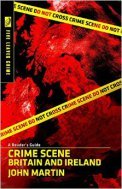 After recently reviewing Barry Forshaw’s Brit Noir, which celebrates contemporary British crime fiction, it came to my attention that another recently published book also looks at crime fiction in the context of setting. Whereas Forshaw’s work concentrates on living crime writers John Martin’s Crime Scene Britain and Ireland looks at both contemporary and historic authors who wrote with a strong sense of place. He concentrates on authors who write about ‘real’ settings or when the fictional place is specifically located, for example, Eastvale, Stephen Booth’s Peak District town.
After recently reviewing Barry Forshaw’s Brit Noir, which celebrates contemporary British crime fiction, it came to my attention that another recently published book also looks at crime fiction in the context of setting. Whereas Forshaw’s work concentrates on living crime writers John Martin’s Crime Scene Britain and Ireland looks at both contemporary and historic authors who wrote with a strong sense of place. He concentrates on authors who write about ‘real’ settings or when the fictional place is specifically located, for example, Eastvale, Stephen Booth’s Peak District town.
The writing is authoritative and engaging and it’s as enjoyable to read of new-to-me authors as to study Martin’s views on old favourites. There is some duplication in entries as Martin wisely tries to ensure that writers such as SJ Bolton are covered in the various regions they use as settings. I particularly enjoyed reading the Midlands chapter and I’ve been left with a long reading list of authors I want to discover. At the end of each chapter there is a ‘Ten Recommended Reads’ which allows readers less familiar with the genre to discover for themselves new authors.
Crime Scene Britain and Ireland sits nicely alongside Brit Noir and I’d recommend fans of the genre to read both. It’s testimony to the strength of British crime fiction that there are such interesting reference books to dip into and savour.


April 11, 2016
Review: Lin Anderson – The Special Dead
A post from guest reviewer, Rachel Hall, of The Special Dead by Lin Anderson
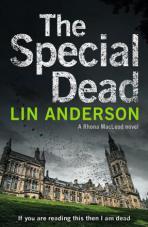 A long overdue introduction to Lin Anderson and her well regarded forensic scientist Rhona MacLeod came in the tenth outing of the series, The Special Dead. It pairs Rhona with newly demoted DS Michael McNab to investigate the ancient practice of Wicca and those that adhere to its teachings. A sensitive subject matter where preconceptions abound and a world which is new to both Rhona and McNab.
A long overdue introduction to Lin Anderson and her well regarded forensic scientist Rhona MacLeod came in the tenth outing of the series, The Special Dead. It pairs Rhona with newly demoted DS Michael McNab to investigate the ancient practice of Wicca and those that adhere to its teachings. A sensitive subject matter where preconceptions abound and a world which is new to both Rhona and McNab.
When well-heeled Edinburgh banker Mark Howitt travels to Glasgow for a weekend on the town with his friend, Jeff, he seems to have struck lucky when the stunning Leila takes him home and orders him to strip. When he wakes the next morning and finds her gone from the bed he opts for a quick escape. Stumbling into the wrong room he is confronted by a sickening scene; behind rows of plastic dolls swaying as they hang from the ceiling he sees the stripped body of the girl he spent the night with. Lost in a cloud of alcohol and cocaine infused excess, his instincts tell him to run. Could he possibly have had a hand in her death or has he simply been fitted up as the fall guy whose DNA is all over the crime scene?
Rhona immediately suspects ritualistic overtones and involves the scholarly forensic psychologist Professor Magnus Pirie, a man who is the antithesis of McNab and whom the wider team are reluctant to accept. When Magnus identifies the red plaited silk cord which the victim was hung from as a cingulum, a Wiccan artefact used in sex magick, it seems that his knowledge could provide the much needed breakthrough. When further discoveries seem to support that theory the first task for the investigative team is to conquer their own scepticism.
In the eyes of the mass media and a large section of society, Wicca still conjures up images of black magic and devil worship and this includes DS McNab who find himself a little outside of his comfort zone. The author has clearly taken considerable time in researching her subject matter and tackles some of the most misunderstood beliefs and delivers a non-judgemental and unbiased portrayal of just what the practice entails. Whilst I would not normally have considered reading a novel surrounding Wicca, Anderson won me over with just how eloquently she pointed out that every perpetrator has what they regard as a rational reason for their actions and to make headway on any investigation efforts need to be made to try to comprehend a crime no matter how bizarre.
Anderson treats her readers with intelligence and raises some important questions about the future of policing most notably with McNab’s feeling of inadequacy when so much of the investigative process now is dominated by the importance of forensics and technology. He finds himself questioning his input and just what value his “instinct, intuition and years of experience can offer” in the course of a modern-day investigation. The role of forensic psychologists is also put into perspective and Anderson considers how suspicious the rank and file officers can be when a forensic psychologist is introduced, often interpreting it as a sign of lost confidence in their abilities.
Anderson’s forensic insight brings an undoubted gravitas to her writing and she offers readers something different, combining the rigours of forensic knowledge with the characters who drive an investigation forward. The undoubted strength in her work is in making forensics both accessible to her audience and recognising that forensics insights alone only afford a partial glimpse into any story. Admittedly I did feel the ending was a little overplayed and questioned McNab’s close contact with witness Freya, but there was more than enough to draw me back to the work of Lin Anderson. The author does a brilliant job of bringing Glasgow alive, and portrays a city whose inhabitants are proud of their reputation as the second city of Scotland known for its characters and individuality against a view of Edinburgh as perhaps a little more stand-offish and overly gentrified.
Combining the forensic rigour with distinctive regional flavour and a team of realistically flawed characters there is more than enough to guarantee that I will return to Rhona MacLeod.


April 4, 2016
Crime fiction news: Two Deals and book covers
It’s been a while since I caught up with some of my own book news on Crimepieces and, as I’ve just come back from an inspiring crime fiction week-end, I thought I’d do a catch-up post.
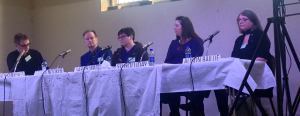 Deal Noir was launched last year and I was a member of the audience listing to the fascinating discussions. This year I was on the debut authors panel talking about In Bitter Chill along with Simon Booker, SJI Holliday and Alison Baillie. Moderated by Andy Lawrence it was fascinating to hear about the other authors’ routes to publication. I’ve reviewed on this blog Holliday’s Black Wood and Baillie’s Sewing The Shadows Together and am looking forward to reading Simon Booker’s debut, Without Trace. Thanks to the organisers, Susan Moody and Mike Linane, for what was a great event.
Deal Noir was launched last year and I was a member of the audience listing to the fascinating discussions. This year I was on the debut authors panel talking about In Bitter Chill along with Simon Booker, SJI Holliday and Alison Baillie. Moderated by Andy Lawrence it was fascinating to hear about the other authors’ routes to publication. I’ve reviewed on this blog Holliday’s Black Wood and Baillie’s Sewing The Shadows Together and am looking forward to reading Simon Booker’s debut, Without Trace. Thanks to the organisers, Susan Moody and Mike Linane, for what was a great event.
A comment by a reader of Crimepieces reminded me that I hadn’t shared the cover of my second book, A Deadly Thaw, in any posts. I now have lovely covers for both the UK and US editions which are out in September. It’s interesting how the designers have interpreted the story for differing markets and I think they both look great. The UK cover is on the left. Both are available to pre-order in bookshops and on Amazon.
On Friday, as I was travelling down to Deal, my publishers Faber and Faber announced that they’ve bought by third and fourth books in my Bampton series. Book three, which I’m currently writing, is provisionally titled A Patient Fury and is set in the summer in the Peak District. I love being at the stage where the story is being put down on the page. Here’s the announcement in the Bookseller.
Thanks to everyone for their support of my writing. I love both writing and reading crime novels and it’s great to have the opportunity to do both. On Wednesday the Petrona judges will be getting together to choose the shortlist for the 2016 Award. It’s interesting how many good books are out there so it will be a tough choice. I’m looking forward to talking crime fiction once more.


March 28, 2016
Review: Barry Forshaw – Brit Noir
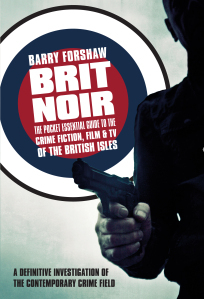 Barry Forshaw’s previous two books in this Pocket Essentials series published by Oldcastle, Nordic Noir and Euro Noir, have been excellent overviews of crime fiction coming from these regions. As a British reviewer, it was inevitable that he would turn his attention to the books coming out of this country but I can’t say I envied him the task. British crime writers are a diverse bunch and writing what is billed as a ‘definitive’ investigation was never going to be easy. Brit Noir, however, is an enjoyable and informative analysis of the genre with plenty of insightful comments on the authors included.
Barry Forshaw’s previous two books in this Pocket Essentials series published by Oldcastle, Nordic Noir and Euro Noir, have been excellent overviews of crime fiction coming from these regions. As a British reviewer, it was inevitable that he would turn his attention to the books coming out of this country but I can’t say I envied him the task. British crime writers are a diverse bunch and writing what is billed as a ‘definitive’ investigation was never going to be easy. Brit Noir, however, is an enjoyable and informative analysis of the genre with plenty of insightful comments on the authors included.
Forshaw divides Brit Noir into geographic regions. This not only mirrors the construction of his earlier books but also reinforces what he considers, in his introduction, to be one of the defining feature of the genre: vividly evoked locales. Splitting up authors like this will never please everyone and, as Forshaw acknowledges in his introduction, there are writers such as Ann Cleeves who set their books in more than one location. What was interesting was the chapter on British writers who choose to set their novels elsewhere: a substantial bunch some of whom reflect the British expat experience abroad in their books.
The other three key elements characterising British crime fiction identified are: strong plotting, literate, adroit writing and complex characterisation. It’ll be interesting to hear if readers agree with this conclusion. Forshaw rightly, in his introduction, mentions the legacy of the Golden Age writers. I was also conscious, while reading the book, of how the more recently deceased PD James and Ruth Rendell have influenced the writing of many of the authors included.
Forshaw gives both new and established authors a significant space in what, at 226 pages, is a short book and it’s an achievement to have included so many writers. Brit Noir is a book to dip into but also, as I did, to read from cover to cover. I’ve always considered Forshaw to be an honest reviewer and the book very much reflects his personality. It made the book a stimulating and, at times, amusing read.
I was delighted to included and am looking forward to other reviews which, I’m sure will generate much discussion.


March 23, 2016
Review: Elly Griffiths – The Woman in Blue
I have to admit to occasionally getting weary of reading crime fiction. It does’t happen 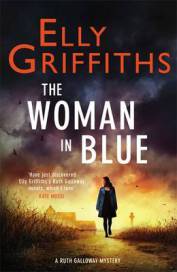 very often as it’s a genre that I’ve loved since I was a child. However, there is so much of it out there to read that I can feel overwhelmed. So, occasionally, I have a break and read something else. My recent binge has been ghost stories and it’s been hugely enjoyable. However, one book has got me back into the crime fiction reading groove and it’s this one by one of my favourite crime writers. Elly Griffiths’s series featuring forensic archaeologist, Dr Ruth Galloway, had me hooked from the start. The books successfully combine both police procedural and a mystery calling for Ruth’s expertise. Set on the Norfolk coast, the books also have a strong sense of place and an unusual cast of characters.
very often as it’s a genre that I’ve loved since I was a child. However, there is so much of it out there to read that I can feel overwhelmed. So, occasionally, I have a break and read something else. My recent binge has been ghost stories and it’s been hugely enjoyable. However, one book has got me back into the crime fiction reading groove and it’s this one by one of my favourite crime writers. Elly Griffiths’s series featuring forensic archaeologist, Dr Ruth Galloway, had me hooked from the start. The books successfully combine both police procedural and a mystery calling for Ruth’s expertise. Set on the Norfolk coast, the books also have a strong sense of place and an unusual cast of characters.
The Woman in Blue is set in Walsingham, a famous Marian shrine and a destination for pilgrimages going back centuries. Ruth’s friend, the druid Cathbad, is house-sitting for a friend when he sees a woman in a graveyard wearing a blue cloak. When, the next morning, a woman is found murdered, DCI Nelson and his team discover she was a patient at a nearby rehab facility. Ruth, meanwhile, has been contacted by a university friend who is now a priest. She claims that someone opposed to ordained women is sending her threatening letters and asks Ruth to help.
For me, this was a perfect combination of one of my favourite crime fiction series and a religious subject matter. I’ve visited Walsingham a few times and it’s an unusual place. The religious elements, however, are never allowed to overshadow the main story, that of women who are being killed, possibly as a result of religious zealotry.
One of the reasons for the series’ continued popularity is the relationship between Ruth and Nelson. Married to the glamorous Michelle, Nelson is the father to Ruth’s daughter and both are ambivalent about whether they could envisage a future with each other. However, the mutual attraction is overwhelming and Griffiths tantalises us once more about the possibility of the two coming together. I find the relationship to be one of the most realistic portrayals of a couple in crime fiction and the ‘will-they-won’t-they’ is never wearying.
If you haven’t read any of Griffiths’s books you could easily begin with The Woman in Blue and I’m sure it will make you want to read more of this excellent series.



